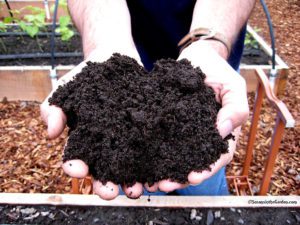April 9 Column: Making Compost

With the garden season getting underway, I decided a column on compost and composting would be in order. After all, if we take care of the soil in our gardens, it in turn will take care of our plants and — in the case of veggies — provide us with higher yields. Sounds good to me!
Here is a link to my column in today’s edition of The Spokesman-Review: Compost is the answer. (or you can read my column lower in this post)
I had the pleasure of meeting Kris Major, who is the education coordinator for the City of Spokane Solid Waste Disposal dept. She is in charge of the Master Composters/Recyclers program, in which folks learn how to create compost and then share that knowledge with the community.
This week’s video:
Compost garden column:
by Susan Mulvihill
Compost is the answer to so many gardening challenges.
If you have sandy soil, compost will add texture to keep water from running right through it. With clay soil, compost breaks up the sticky soil particles to improve drainage and aeration. Soil lacking in fertility and plants without vigor will be dramatically improved with the addition of compost.
If you want to cut down on the amount of natural materials you’re paying to dispose of or do good things for the environment, compost is the way to go.
Meet Kris Major
Kris Major knows the benefits of compost all too well. As education coordinator for the City of Spokane Solid Waste Disposal department, she teaches classes for their Master Composters/Recyclers program to those eager to learn.
“Each year, our program runs from late March through April,” she explained. “Students spend five weeks learning about composting, compost tea, soil health and composting with worms. Then they get to share what they’ve learned with the public through community outreach.”
How to make compost? Here’s the big picture:
“You need air, water, and materials that contain carbon and nitrogen,” Major said. “Everything is going to rot eventually, but the secret is in how you mix those elements, how much moisture you add, and the size pile you have.”
She suggests locating your compost pile in an area convenient for getting the materials to it and close to a water source.
“It doesn’t matter what type of bin you use, just something that holds the materials in the correct mass,” she said. “A 3-feet-square pile is ideal, but no bigger than 5 feet square as it might compress too much.”
How this process works
It can be easy to feel overwhelmed by the science of composting but, generally speaking, you should aim for two parts green materials (nitrogen) to one part brown materials (carbon). Refer to the materials information box for guidelines.
“If you use chipped or shredded materials, they’ll break down faster because there will be more surface area for the microorganisms to chow down on,” Major said. “And if you add moisture so the pile is as wet as a wrung-out sponge, you’re off and running.”
Turning a compost pile provides microorganisms with new food sources and increases air circulation. How often you turn a pile depends on how quickly you want finished compost. Active composters who turn piles regularly can achieve this in eight to 10 weeks. Passive compost piles with little to no turning can take anywhere from one to four years to finish decomposing.
Major believes strongly in the value of composting.
“In a recent study, the Department of Ecology learned that a third of our waste stream — everything we throw in the garbage — could have been composted,” she said. “I’d like people to think a little more about the loss of that valuable resource. If it goes to a landfill or the Waste-to-Energy plant, it’s gone. All that beautiful carbon and nitrogen could have gone into the soil. You can’t get it back.”
Those interested in learning about composting or participating in the Master Composters/Recyclers program can call (509) 625-6580 or go to my.spokanecity.org/solidwaste/education/. They can also visit the compost learning area in the Green Zone at Spokane County Extension seven days a week. It is located adjacent to the south parking lot at 222 N. Havana St. and includes different types of composting bins and compost at various stages of decomposition.
Materials that can be composted:
GREENS (NITROGEN)
Grass clippings
Garden plants (fresh)
Vegetable and fruit trimmings
Food waste (no meat, fats or dairy)
Coffee grounds
Weeds that haven’t gone to seed
Poultry, cow or sheep manure
BROWNS (CARBON)
Fallen leaves
Dried plant material
Hay
Dry weeds (without seeds)
Shredded office paper
Corrugated cardboard
Pine needles
MATERIALS TO AVOID
Meat
Bones
Dairy Products
Fatty foods, cooking oil, salad dressing
Dog, cat or pig manures
Weeds that have gone to seed
*Source: Spokane County Master Composter/Recycler Program

